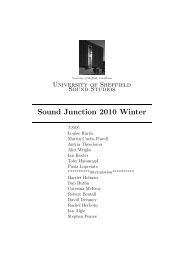Compositional Methods in Electroacoustic Music - Adrian Moore ...
Compositional Methods in Electroacoustic Music - Adrian Moore ...
Compositional Methods in Electroacoustic Music - Adrian Moore ...
You also want an ePaper? Increase the reach of your titles
YUMPU automatically turns print PDFs into web optimized ePapers that Google loves.
2 Wednesday 30th January 2013<br />
2.1 Workshop 1<br />
USSS Tools<br />
10:00<br />
<strong>Moore</strong>, <strong>Adrian</strong><br />
2.2 Paper Session 1<br />
Paper 1 - Directions <strong>in</strong> embodied acousmatics.<br />
10:00<br />
O’Ria<strong>in</strong>, Damian<br />
In apprais<strong>in</strong>g alternatives to ‘classical acousmatic composition,’[1] it might be possible to argue that forms<br />
such as underground dance music, experimental electronica, noise-based music, immersive ‘space-music,’ and<br />
sonic art practices that blur the boundaries between these doma<strong>in</strong>s,[2] bear little relationship to the tradition<br />
of musique acousmatique. However, just as the acousmatic concert places great emphasis on the ‘experience’<br />
(be it sound alone, sound mov<strong>in</strong>g <strong>in</strong> space, or an overall sense of sound dramaturgy), vernacular or ‘popacousmatic’[3]<br />
music also requires the listener to partake <strong>in</strong> a ‘sonic experience’. In both <strong>in</strong>stances we are <strong>in</strong><br />
effect witness<strong>in</strong>g a fetishisation of sound; it is sound for sound’s sake[4] (no negative connotation is <strong>in</strong>tended).<br />
Additionally, both traditional acousmatics and popular varieties exploit sound as a means of engender<strong>in</strong>g a<br />
tactile engagement with sound phenomena. In the traditional sphere, a perception of tactility manifests itself<br />
transmodally;[5] sound triggers associations <strong>in</strong> the m<strong>in</strong>d of the listener, which leads to causative assessments<br />
derived from tactile memory.[6] In the popular counterpart, by virtue of the sound pressure levels <strong>in</strong>volved,<br />
the sound has a direct physical impact;[7] it is literally felt[8] (and often with this comes a sense of immersion[9]).<br />
With the above <strong>in</strong> m<strong>in</strong>d we can beg<strong>in</strong> to view all of this music, irrespective of perceived stylistic differences<br />
that might exist, as be<strong>in</strong>g concerned with embodied experience.<br />
[1] Emmerson (2007:31)<br />
[2] Demers (2010:159-162)<br />
[3] Milutis (2008:71)<br />
[4] I am apply<strong>in</strong>g the idealised Schaefferian conception here. Atk<strong>in</strong>son (2007:120) highlights that many composers<br />
have moved away from a strict read<strong>in</strong>g of acousmatic theory to an acceptance of ‘<strong>in</strong>dicative listen<strong>in</strong>g’<br />
and a consideration of the extr<strong>in</strong>sic aspects of sound.<br />
[5] Smalley (2007) states: ‘Our sense of texture is learned through vision and touch as well as sound; our experience<br />
of the physical act of sound mak<strong>in</strong>g <strong>in</strong>volves both touch and proprioception; spectral motion, and<br />
the movement and distribution of sounds <strong>in</strong> space relate to our own experience of physical motion and cultural<br />
and natural environments.’<br />
[6] Gallace and Spence (2009:380-406) suggest ‘that at least part of the neural network <strong>in</strong>volved <strong>in</strong> the memory<br />
for touch might be shared among different sensory modalities. In particular, multisensory/amodal <strong>in</strong>formationprocess<strong>in</strong>g<br />
networks seem to play a lead<strong>in</strong>g role <strong>in</strong> the storage of tactile <strong>in</strong>formation <strong>in</strong> the bra<strong>in</strong>.’<br />
[7] The exaggerated reproduction of lower registers, so called sub-bass, is a preoccupation of virtually all posttechno<br />
electronic dance music, and its derivatives, but its orig<strong>in</strong>s stretch back to the <strong>in</strong>troduction of the twelve<strong>in</strong>ch<br />
s<strong>in</strong>gle <strong>in</strong> the late 1970s (Gilbert and Pearson:134-135). Many post-digital musicians excel at generat<strong>in</strong>g<br />
tweeter ruptur<strong>in</strong>g ‘clicks and cuts’ that are felt with<strong>in</strong> the aural cavity rather than simply heard. When<br />
both extremes are comb<strong>in</strong>ed, there is sense of be<strong>in</strong>g simultaneously immersed <strong>in</strong>, and penetrated by, waves of<br />
sound. Hegarthy (2009:143) <strong>in</strong> discuss<strong>in</strong>g extreme volume <strong>in</strong> ’noise music’ notes that ‘the volume [I assume he<br />
means sound pressure waves] structures the listen<strong>in</strong>g space, and engages bodily hear<strong>in</strong>g.’<br />
[8] Of course transmodal factors may also be at play.<br />
[9] Emmerson (2007:155-164)<br />
3



